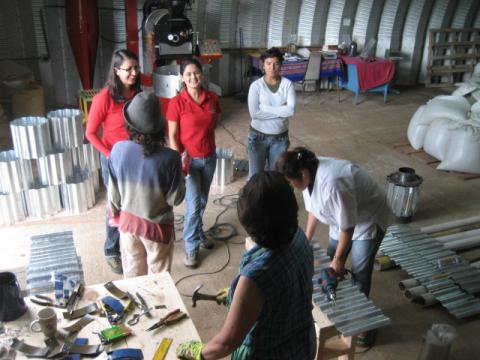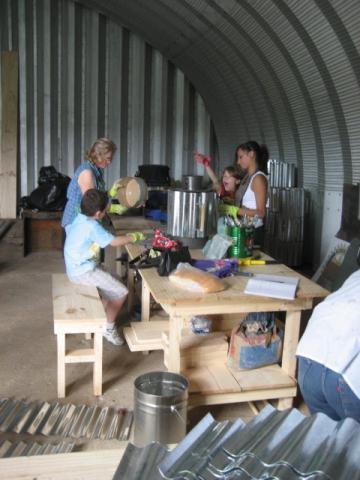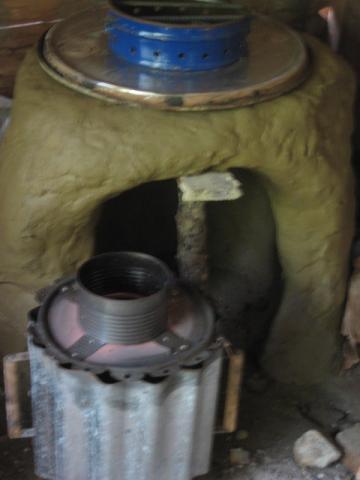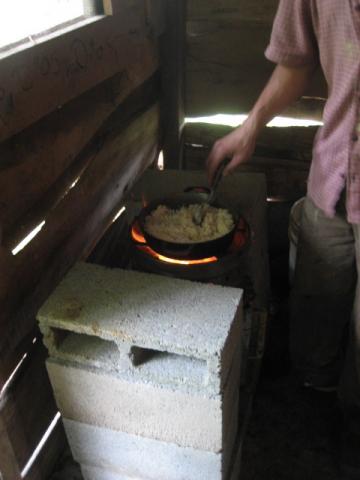From Art's Preface:
Buenas,
Just a quick note from Costa Rica. Our Estufa Finca (a large TLUD) team is two weeks into preparing for a 10 week pilot project. Working with SALTRA and a program at the Universidad Nacional de Costa Rica, we will be installing 50 , locally produced stoves with migrant coffee bean pickers.
I want to side with Paal on this very important point. Our stoves can have the best looking numbers in the lab. But if people won't use them it doesn't make much difference does it. The stove design we are using has been jointly developed by myself, my Central American partners (esp. the women who are building them APORTES), but most esp. by listening very carefully to the people who we hope to benefit. Much of the feed back has been in regard to the fuels issue. These people do not have access to chips or pellets, we are not going to get them to make briquttes, etc... so instead we have given them a fuel chamber easy to load with sticks, sugar cane bagasse, etc. and powerful enough to cook for the typically large extended families. This process stared in August 2009, there are currently 20 of our stoves being used in CR and Nicaragua, the feedback has been very positive. The pilot project is simply a continuation of that process. We are going to be using the KPT version 3.0 protocol, with some customization to monitor 30 stoves. All of us on the team are looking forward to adding more TLUD based stoves to our line. But this approach is showing us what will get used in the real world.
I want to side with Paal on this very important point. Our stoves can have the best looking numbers in the lab. But if people won't use them it doesn't make much difference does it. The stove design we are using has been jointly developed by myself, my Central American partners (esp. the women who are building them APORTES), but most esp. by listening very carefully to the people who we hope to benefit. Much of the feed back has been in regard to the fuels issue. These people do not have access to chips or pellets, we are not going to get them to make briquttes, etc... so instead we have given them a fuel chamber easy to load with sticks, sugar cane bagasse, etc. and powerful enough to cook for the typically large extended families. This process stared in August 2009, there are currently 20 of our stoves being used in CR and Nicaragua, the feedback has been very positive. The pilot project is simply a continuation of that process. We are going to be using the KPT version 3.0 protocol, with some customization to monitor 30 stoves. All of us on the team are looking forward to adding more TLUD based stoves to our line. But this approach is showing us what will get used in the real world.
From the Lab Report: Testing Results of Estufa Finca
November 24, 2010
For more detail and pictures see the attached file:
http://stoves.bioenergylists.org/files/estufa_finca_report.pdf
The design of the Estufa Finca TLUD (top light up-draft), developed by SeaChar, draws from the work of Dr. Tom Reed, Dr. Paul Anderson, and many others who have applied gasification techniques to low cost cook stove technology. The central idea behind gasification is to separate the gasses from the heated biomass and burn them efficiently in a separate “pyrolysis front”. Gasifiers are known to leave behind charcoal that can be removed as a “value added” product. SeaChar promotes this produced charcoal as a soil amendment.
The Estufa Finca consists of a 20-liter can combustion chamber surrounded by shell of galvanized roofing. The shell preheats and channels secondary air into the combustion chamber. It also acts as a heat shield that keeps the combustion chamber hot and the exposed surface of the stove cool. A riser made from a coffee can is attached to the top of the combustion chamber. A stable pot support fits over the riser. An Altoids can attached to the bottom of the stove acts as the primary air control door. The reported results are for this initial design, even though numerous iterations were investigated.
The Estufa Finca is versatile at burning biomass. Practically any size, shape, or type of fuel can be burned. This is possible because of the size of the combustion chamber and the primary air control. The combustion chamber is large enough that sticks and twigs can be easily loaded into the stove, as well as small pieces of biomass such as pellets, chips, and shells. Good control of the primary air intake allows the stove to be tuned to burn the many different types of biomass.
The stove was tested under the Aprovecho portable emissions collection hood, in which real-time emissions of CO2, CO, and PMTSP were recorded. The system also measured the flow rate of the diluted exhaust gases, enabling mass-based calculations of the emissions produced during the test.
The Estufa Finca was tested using the UCB Water Boiling Test (WBT). The first phase of the test consists of a high-power analysis in which 5 Liters of water are brought to a boil in an uncovered 7 Liter pot. In the low power phase of the test, 5 Liters of water are simmered at about 3 degrees C below full boiling temperature for 45 minutes. The stove was tested using sticks (approximately 1 cm X 4 cm by 15 cm long) of kiln-dried Douglas fir at 11.2% moisture content (on a wet basis).
Fuel Use
The Estufa Finca is a very powerful stove. The average power output during the high power phase of the WBT was recorded as high as 14,000 W, which is equivalent to the power output of a 60 liter institutional stove. A regular household rocket stove is more on the order of 4,000 W. The power output of the Estufa Finca is a little excessive for the 5 liter WBT. As a result, the stove had relatively high fuel consumption for this particular cooking task, and it did not meet the benchmark for fuel use.
Emissions
The emissions of the Estufa Finca are extremely low. Aprovecho has set clean cookstove benchmarks for emissions at 20 grams of CO and 1500 mg of PM to complete the simulated cooking task of the WBT. While it produced an average of 26 grams of CO in our tests, we found that the Estufa Finca is capable of meeting the CO benchmark (having produced 14.1 and 17.2 g CO in two of the tests). The stove easily exceeded the PM benchmark, producing an average of 573 mg of PM (one third of the benchmark). It is remarkable that such a high power stove is capable of meeting the benchmarks for emissions for a test intended for lower power stoves.
Now that we have results for emissions per consumption of fuel wood, we can evaluate the possible emissions of this stove versus an open fire once fuel consumption for the two stoves is determined in the field. If, in the field, the Estufa Finca uses the same amount of fuel as the 3 stone fire, then we can project an 83% reduction in CO emissions and a 91% reduction in PM emissions. If the Estufa Finca uses less fuel than the 3 stone fire in the field, the projected reductions in emissions will be even greater.




